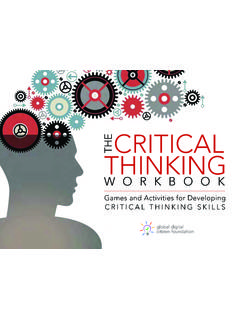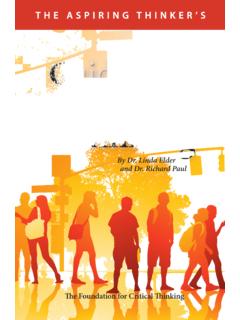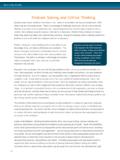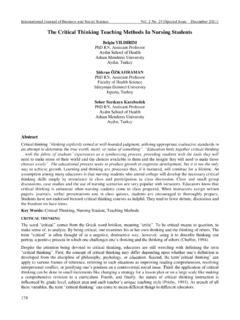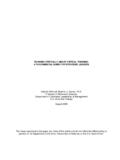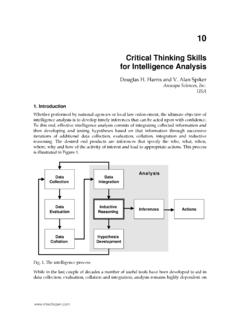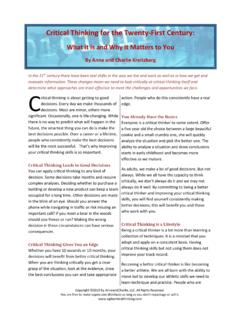Transcription of Thinking Skills: Critical Thinking and Problem Solving
1 9781107606302 John Butterworth and Geoff Thwait Thinking skills Second edition Cover C M Y KISBN 978-1-107-66996-3 Critical Thinking and Problem SolvingSecond editionThinking SkillsJohn Butterworth and Geoff ThwaitesThinking skills Butterworth and ThwaitesThis lively coursebook encourages students to develop more sophisticated and mature Thinking processes by learning speci c, transferable skills independent of subject content which assist con dent engagement in argument and well as giving a thorough grounding in Critical Thinking and Problem Solving , the book discusses how to analyse and evaluate arguments, manipulate numerical and graphical information and develop a range of skills including data handling, logic and reasoning. The second edition of the book has been substantially updated with new and revised content throughout.
2 The only endorsed coursebook offering complete coverage of the Cambridge AS and A Level Thinking skills syllabus, this resource also contains extensive extra material to cover a wide range of related include: clearly focused and differentiated Critical Thinking and Problem Solving units that provide complete coverage of the Thinking skills syllabus and beyond a range of stimulating student activities with commentaries to develop analytical skills summary of key concepts at the end of each chapter to review learning end-of-chapter assignments to reinforce knowledge and skills , with answers at the back for self-assessment a mapping grid to demonstrate the applicability of each unit to awards including Critical Thinking , BMAT and skills is written by two experienced examiners, who have produced a lively and accessible text which all students of Thinking skills will nd for information on our full range of Cambridge International A Level titles including e-book versions and mobile skills Critical Thinking and Problem Solving Second editionJohn Butterworth and Geoff ThwaitesCritical Thinking and Problem SolvingSecond editionThinking SkillsJohn Butterworth and Geoff Thwaitesc a m b r i d g e u n i v e r s i t y p r e s sCambridge, New York, Melbourne, Madrid, Cape Town, Singapore, S o Paulo, Delhi, Mexico CityCambridge University PressThe Edinburgh Building, Cambridge CB2 8RU, on this title: Cambridge University Press 2005, 2013 This publication is in copyright.
3 Subject to statutory exceptionand to the provisions of relevant collective licensing agreements,no reproduction of any part may take place without the written permission of Cambridge University published 2005 Second edition 2013 Printed in Italy by catalogue record for this publication is available from the British LibraryISBN 978-1-107-60630-2 PaperbackCambridge University Press has no responsibility for the persistence oraccuracy of URLs for external or third-party internet websites referred to inthis publication, and does not guarantee that any content on such websites is,or will remain, accurate or appropriate. Information regarding prices, traveltimetables and other factual information given in this work is correct atthe time of first printing but Cambridge University Press does not guaranteethe accuracy of such information thereafter.
4 Contents iiiUnit 1 Thinking and reasoning Thinking as a skill 1 An introduction to Critical Thinking 7 Solutions not problems 13 Unit 2 Critical Thinking : the basics Claims, assertions, statements 16 Judging claims 21 Argument 28 Identifying arguments 33 Analysing arguments 38 Complex arguments 43 Conclusions 50 Reasons 58 Assumptions 63 Flaws and fallacies 70 Unit 3 Problem Solving : basic skills What do we mean by a Problem ? 79 How do we solve problems? 82 Selecting and using information 86 Processing data 90 Finding methods of solution 93 Solving problems by searching 98 Recognising patterns 102 Hypotheses, reasons.
5 Explanations and inference 106 Spatial reasoning 112 Necessity and sufficiency 116 Choosing and using models 119 Making choices and decisions 123 Unit 4 Applied Critical Thinking Inference 126 Explanation 137 Evidence 144 Credibility 150 Two case studies 156 Critical Thinking and science 163 Contentsiv Contents Introducing longer arguments 170 Applying analysis skills 177 Critical evaluation 183 Responding with further argument 191 A self-assessment 195 Unit 5 Advanced Problem Solving Combining skills using imagination 205 Developing models 211 Carrying out investigations 220 Data analysis and inference 225 Unit 6 Problem Solving : further techniques Using other mathematical methods 231 Graphical methods of solution 235 Probability, tree diagrams and decision trees 240 Have you solved it?
6 246 Unit 7 Critical reasoning: Advanced Level Conditions and conditionals 249 Soundness and validity: a taste of logic 254 Non-deductive reasoning 262 Reasoning with statistics 269 Decision making 279 Principles 287 An argument under the microscope 295 Critical writing 301 Answers to assignments 311 Appendix 342 Acknowledgements 344 Index 345 Thinking as a skill 1 This book is about Thinking . But it is not about any Thinking . It is about those kinds of Thinking that take conscious effort, and which can be done well or badly.
7 Most of our Thinking takes little or no conscious effort. We just do it. You could almost say that we think without Thinking ! If I am asked whether I would like coffee or tea, I don t have to exercise skill to reply appropriately. Similarly if I am asked a factual question, and I know the answer, it takes no skill to give it. Expressing a preference or stating a fact are not in themselves Thinking skills . There are language and communication skills involved, of course, and these are very considerable skills in their own right. But they are contributory skills to the activities which we are calling Thinking .This distinction is often made by assigning some skills a higher order than others. Much work has been done by psychologists, educationalists, philosophers and others to classify and even rank different kinds of Thinking .
8 Most would agree that activities such as analysis, evaluation, Problem Solving and decision making present a higher order of challenge than simply knowing or recalling or understanding facts. What distinguishes higher orders of Thinking is that they apply knowledge, and adapt it to different purposes. They require initiative and independence on the part of the thinker. It is skills of this order that form the content of this are acquired, improved, and judged by performance. In judging any skill, there are two key criteria: (1) the expertise with which a task is carried out; (2) the difficulty of the task. We are very familiar with this in the case of physical skills . There are basic skills like walking and running and jumping; and Unit 1 Thinking and as a skillthere are advanced skills like gymnastics or woodwork or piano playing.
9 It doesn t make much sense to talk about jumping well unless you mean jumping a significant distance, or clearing a high bar, or somersaulting in mid-air and landing on your feet. There has to be a degree of challenge in the task. But even when the challenge is met, there is still more to be said about the quality of the performance. One gymnast may look clumsy and untidy, another perfectly controlled and balanced. Both have performed the somersault, but one has done it better than the other: with more economy of effort, and more first of these two criteria also applies to Thinking . Once we have learned to count and add, tell the time, read and understand a text, recognise shapes, and so on, we do these things without further thought, and we don t really regard them as skilled. You don t have to think hard unless there is a hard Problem to solve, a decision to make, or a difficult concept to understand.
10 So, as with physical performance, we judge Thinking partly by the degree of challenge posed by the task. If a student can solve a difficult Problem , within a set time, that is usually judged as a sign of greater skill than Solving an easier , when it comes to assessing the quality of someone s Thinking , matters are more complicated. Mental performance is largely hidden inside a person s head, unlike physical performance which is very visible. If two students give the same right answer to a question, there is no telling from the answer alone how it was reached. One of the two may simply have known the answer, or have learned a mechanical way to obtain it or 2 Unit 1 Thinking and reasoningto suggest that there are two distinct ways of Thinking : cold hard reason on one hand and free-ranging creativity on the other. In fact, there is so much overlap and interdependence between the two that it is very difficult to say where one begins and the other ends.
